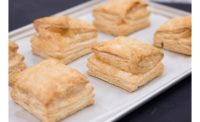Snack Food & Wholesale Bakery was recently able to talk to Dennis Strayer, United Soybean Board consultant, and Andy Fabin, United Soybean Board director and a Pennsylvania farmer who grows soybeans, corn, wheat and cover crops, about the benefits of high oleic soybean oil in bakery products.
Liz Parker: How are high oleic soybean oil and shortenings proven solutions in puff pastry applications?
Dennis Strayer: The United Soybean Board (USB) has run multiple functionality studies, including an evaluation of puff pastries made with laminated doughs utilizing high oleic soybean margarine, conventional soybean margarine, palm margarine, or butter. The tests compared the finished products and found that the pastries made from a high oleic-based soybean margarine outperformed the alternatives in terms of bake height and structure, as well as the desired honeycomb textures. Additionally, the puff pastries made from high oleic soybean margarine performed on par with pastries made using butter which is considered the “gold standard” for puff pastries. The high oleic soybean margarine, used in a laminated dough application, displayed a wider working temperature range, excellent melting properties, and general ease of workability compared to other solutions tested. Lastly, the pastries made using a high oleic soybean margarine mimicked the pastries made from partially hydrogenated oil (PHO) baker’s margarine, which was the dependable workhorse used by bakers for many years. In fact, the high oleic soybean margarine was found to be a drop-in replacement for PHO margarines, which are now banned for use in food products.
LP: How has high oleic soybean oil outperformed other high-stability options, such as 75 percent oleic canola oil?
DS: Both high oleic oils are resistant to oxidation and have similar organoleptic and analytical properties. The bigger differences between these oils are in their price point, the product’s country-of-origin, and the sustainability protocols practiced by the farmers. High oleic soybean oil is an economical high-stability choice that is grown by U.S. farmers using sustainable farming methods.
Andy Fabin: U.S. soybean farmers are committed to sustainable farming practices to ensure we preserve the land for generations to come. Because we are committed to farming sustainably, it’s really great to see consumers creating demand for sustainably grown food. Just under six in ten (59 percent) consumers are now aware of the term "sustainable farming" and 70 percent feel that foods produced using methods and practices that contribute to the long-term health of the environment is important. It’s humbling to know that people appreciate the hard work we put in every day to grow their food.
LP: How can high oleic soybean oil produce baked goods similar in texture, interior grain, spread, height, and size to products using partially hydrogenated soybean oil?
DS: When the partial hydrogenation process lost generally recognized as safe (GRAS) status, the shortening manufacturers turned to another established processing tool that also modifies the solidification and melting characteristic of oils, also known as the interesterification process. This process does not create any trans fatty acids (trans fat) in the shortening unlike the partial hydrogenation process. This process also involves blending two or more oils that are then interesterified, creating a shortening with modified physical properties compared to a straight blend of the oils.
Shortening manufacturers discovered that interesterifying a blend of the liquid high oleic soybean oil with a solid, fully hydrogenated oil, produced an optimal ratio of solids to liquid at the critical temperatures needed to consistently produce finished baked goods. Because of the interserification process, those baked goods had a desired appearance and eating qualities that bakers had with the partially hydrogenated soybean shortenings and margarines. In fact, the interesterified high oleic soybean blends are a direct replacement for the PHO shortenings and margarines without any sacrifice needed to the baker’s operations or the finished baked good’s attributes.
LP: How has high oleic soybean oil performed on functionality tests?
DS: USB has conducted a number of functionality and sensory tests in partnership with Stratas Foods, comparing high oleic soybean oils, shortenings, and margarines to commercially available conventional oils as well as other high stability and high oleic oils products. The testing was conducted in frying and bakery applications, such as doughnuts, cookies, pie crust, puff pastry, white cakes, and icing. In each case, the high oleic soybean oil performed equal to or better than the other oils tested. The high oleic soybean oil proved to have a neutral flavor profile, be resistant to oxidation, and had finished product attributes that met or exceeded expectations for the baked or fried food.
Related: Q&A with United Soybean Board: Using soybean oil in snacks and bakery products
-(2).jpg?1631140111)




